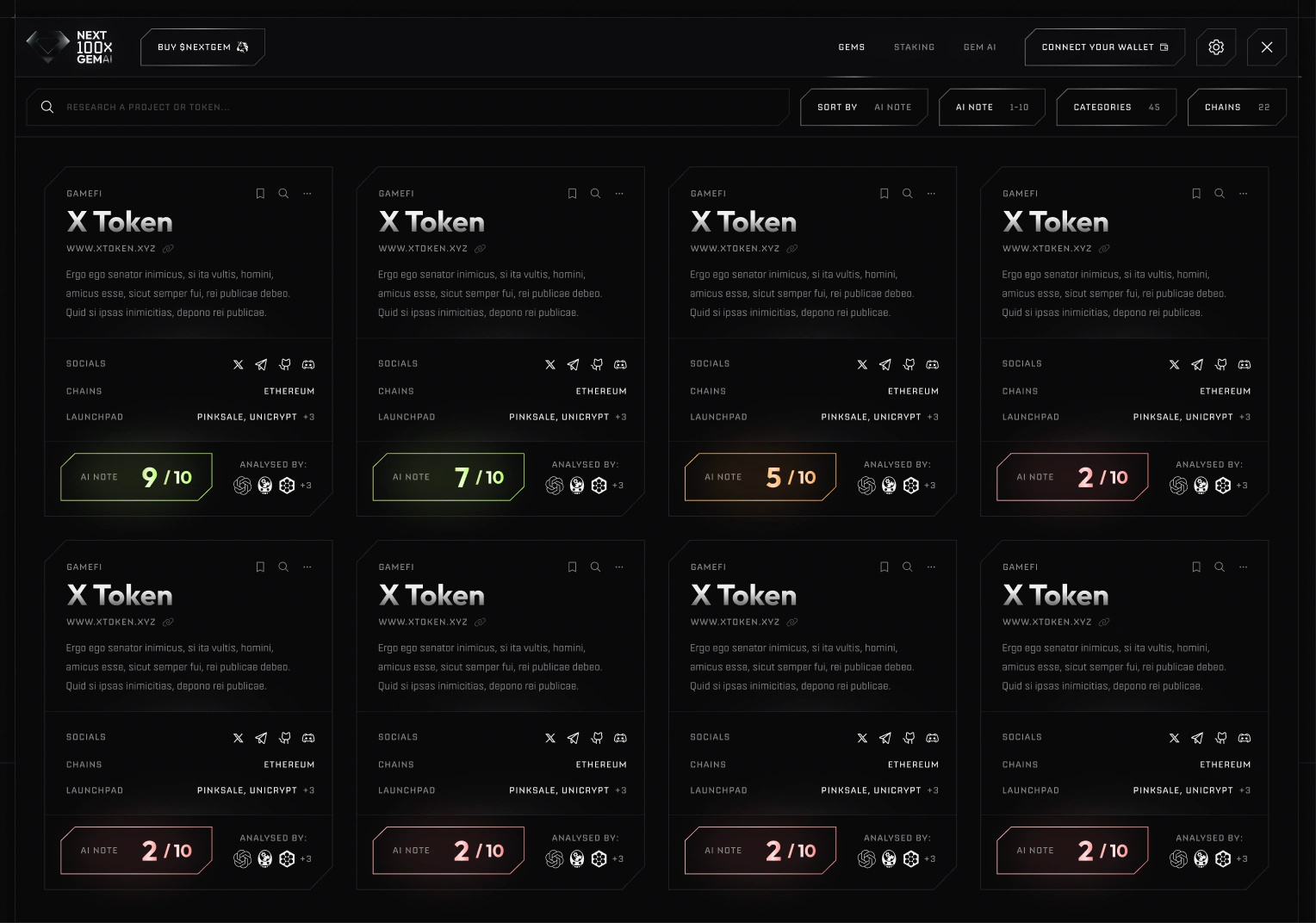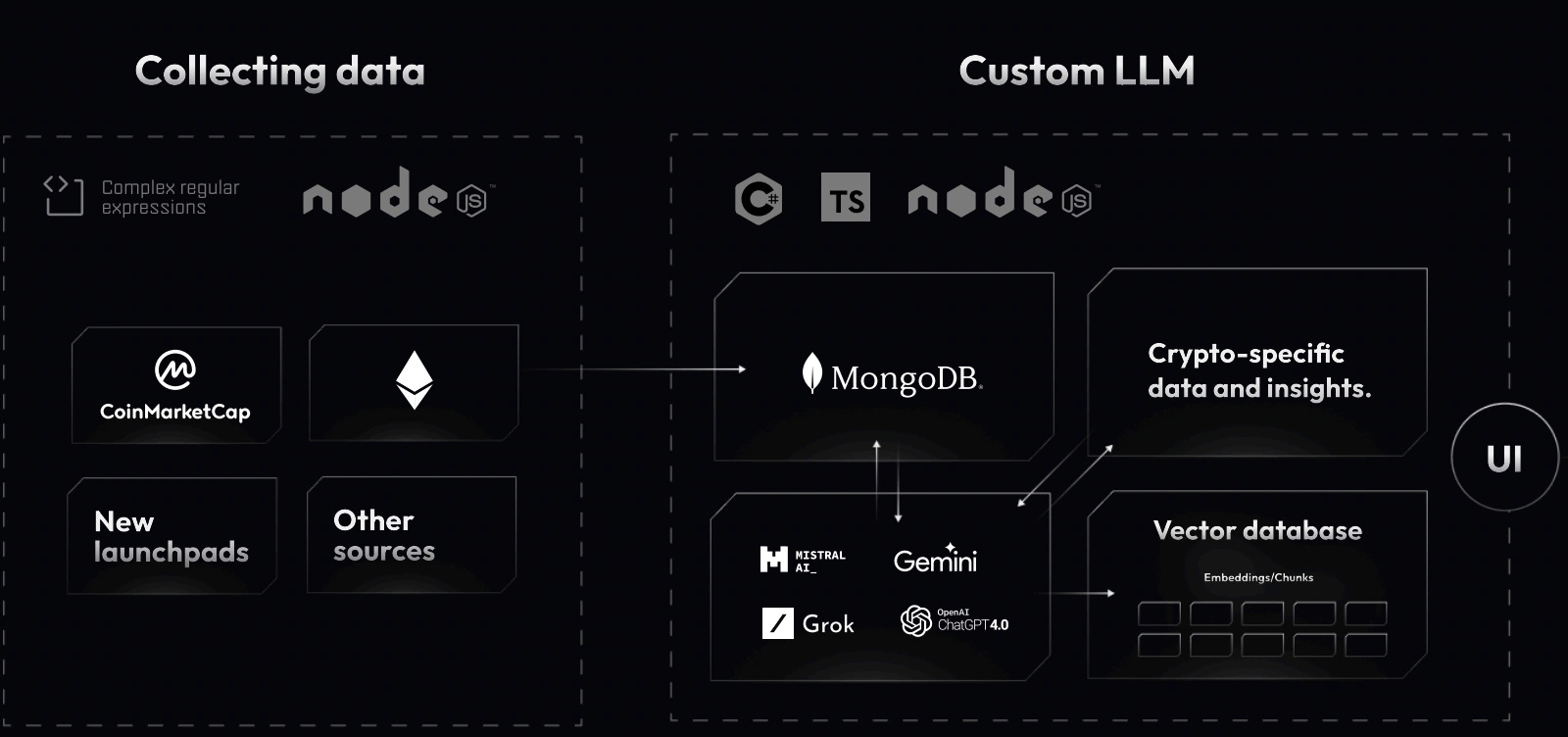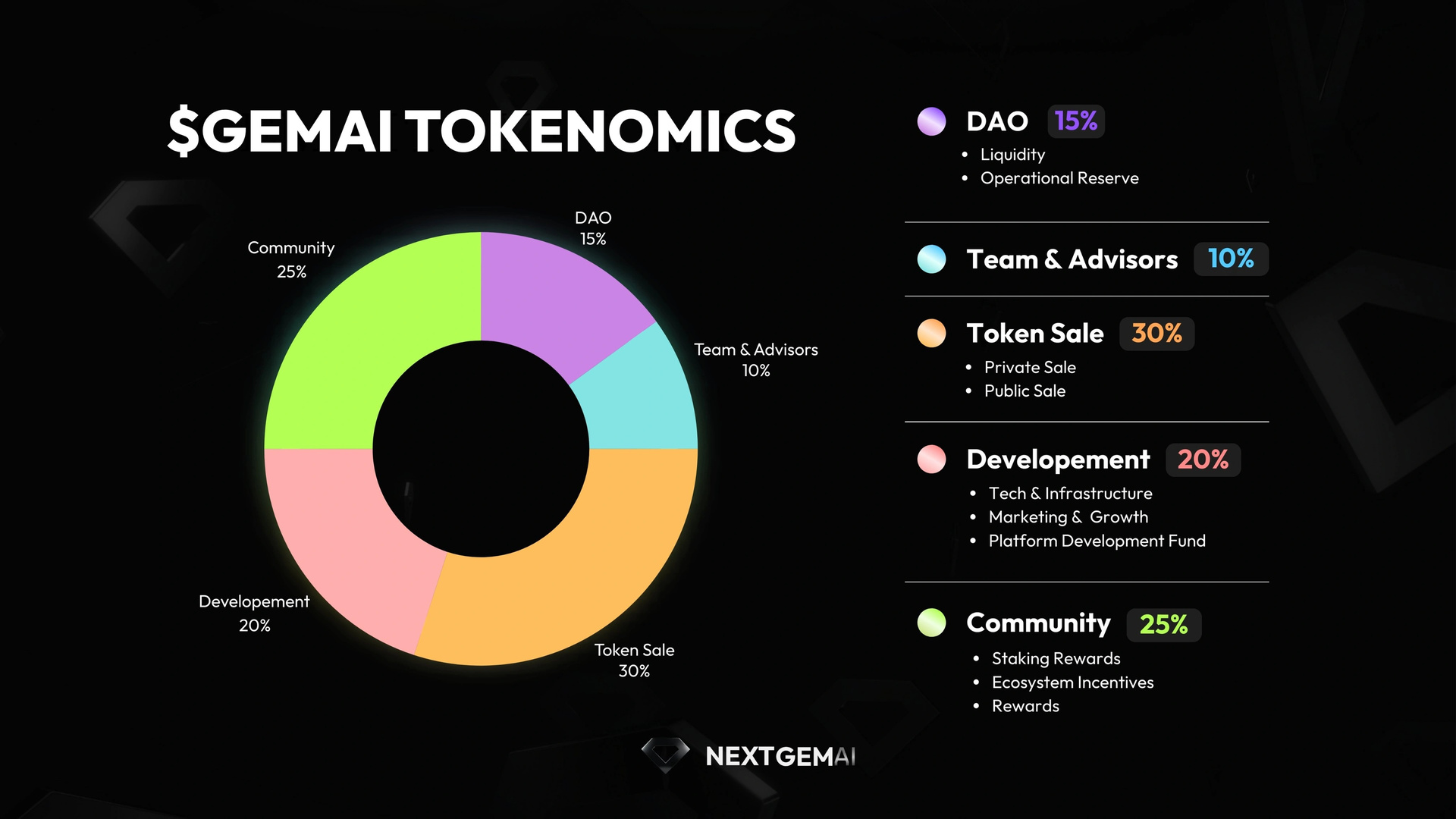Read
Edit
History
Notify
Share
The Next Gem
The Next Gem is a platform that uses advanced AI to analyze and score crypto projects, helping users identify promising opportunities. It combines real-time data collection with sophisticated machine learning models to provide detailed insights into Web3 developments. [1]
Overview
The Next Gem focuses on advancing crypto data research and analysis by building software tools that use curated large language models (LLMs) to gather and analyze data on Web3 projects during the pre-launch and launch stages. These tools aim to provide efficient ways to invest in promising crypto projects across various blockchains. The Next Gem AI extracts project data, analyzes it, and scores projects based on predefined criteria. The platform aspires to be a key resource for analysis and investment, similar to CoinMarketCap’s role in price tracking. [2][3]
The Next Gem AI evaluates tokens by analyzing: [2][4]
- Project documentation, such as whitepapers, to understand objectives and technology
- Market data to assess real-time trends and potential
- Blockchain transactions to review smart contract security and functionality
- Community sentiment on social media to gauge engagement
- Tokenomics, examining distribution, utility, and financial viability
- Code, assessing quality and originality through GitHub
The platform leverages LLMs to summarize and score project information, aiming to improve due diligence by filtering out irrelevant data. While Next Gem provides advanced tools to identify promising projects, success depends on careful application and market awareness. [4]
Features
LLM Efficiency
The Next Gem AI collects and stores data from various crypto projects in its MongoDB database, utilizing powerful AI models like GPT-4, GEMINI AI, MISTRAL AI, and GROK AI. These models categorize projects based on established criteria and rules, evaluated by AI and industry experts to determine each project's reliability and assign corresponding scores. [5]
The LLM back-end processes are developed in C# or Node.js (TypeScript) and interact with APIs from different AI companies. Data extracted from scrapers is processed in a secure cloud environment, with specific tasks assigned to ensure the models follow precise instructions. By maintaining a low LLM temperature, the system avoids creative outputs, guiding the models to perform as intended. The software waits for new projects to be sent for analysis through internal HTTP requests or by filtering unprocessed projects directly from the MongoDB database. [5]
Web Data Scraping
The Next Gem compiles a comprehensive list of new and existing crypto projects by scraping data from centralized sources, like CoinMarketCap, and decentralized platforms, such as newly launched presale smart contracts. This process begins with filtering essential data using complex regular expressions managed by Node.js programs simulating a web browser environment. These programs actively search for new projects in real time and connect to blockchain smart contracts, like Ethereum pre-sale launchpads, to extract relevant textual data. [6]
Once the data is collected, it is stored in a MongoDB database before moving to a second layer of analysis. This deeper analysis involves extracting community details and additional project information directly from the website, including text, images, documentation, whitepapers, and team information. All data is temporarily stored and processed using the Levenshtein distance algorithm to check for accuracy and eliminate duplicates. [6]
Further scrutiny involves analyzing the project's roadmap to assess the team’s goals and vision. The tokenomics, such as token utility and circulating supply at the Token Generation Event (TGE), are also reviewed. Additionally, the source code from the project’s public GitHub repository is analyzed by AI models to ensure originality and adherence to quality standards. [6]
Custom LLM
The Next Gem AI enhances its analysis capabilities by customizing a Large Language Model (LLM) to refine output and provide more valuable insights. Information processed by various AI systems is stored in a MongoDB database, allowing the LLM to access collective knowledge from multiple models. This custom LLM cross-references scores from different models to generate a final score and establish a Trustability factor, helping users make informed investment decisions based on the best available data. [7]
Documents are broken into smaller text segments, or chunks, converted into numerical representations called embeddings. These embeddings capture the core information and are stored in a vector database for efficient searching. When a user asks a question, the system embeds the query to understand its context, searches the vector database for similar embeddings, and retrieves relevant chunks of information. The system then generates a response using this context, ensuring precise and contextually relevant answers to user inquiries. This process allows the custom LLM to deliver more accurate and tailored project analyses. [7]
Premium
The Next Gem AI's Premium provides access to additional project details and restricted areas, including direct interaction with the AI, which has access to computed results in a private database. Subscriptions are available in three intervals: one month, six months, and one year, with discounts offered based on the duration. The subscription is activated by burning a certain amount of $GEMAI through a transaction on the Ethereum blockchain recorded in a smart contract. [8]
GEMAI
The $GEMAI token is used to access premium AI features, including the custom LLM. Users spend $GEMAI tokens to unlock time-limited premium services. The token-burning mechanism is deflationary, reducing the overall supply and promoting sustainable growth. Over time, as burning becomes less feasible, a transition to a locking model is planned, requiring users to lock $GEMAI tokens for specific periods to access premium features. This structure balances user benefits and operational efficiency, supporting community engagement and platform expansion. [9]
Tokenomics
GEMAI has a total supply of 850M tokens and has the following distribution: [10]
- Public Round: 19%
- Ecosystem Incentives/Rewards: 14.5%
- Private Round: 12%
- Liquidity: 10%
- Marketing: 10%
- Team/Advisors: 10%
- Staking Rewards: 9.5%
- Platform Development: 5%
- Operational Reserve: 5%
- Technology/Infrastructure: 5%
Partnerships
- MindAI
- SoonVerse
- TrendX
- Fightly
- MasterPop
- Dechat
- Koi
- Petoshi
- Bitgert
- SatsRush
- Patex
- VanarChain
- Trex20
- MAIV
- RoboHero
- Ordify
- HeLa
- Sugar Kingdom Odyssey
- Bitget
- Raiinmaker
- Hybrid
The Next Gem
Commit Info
Edited By
Edited On
October 15, 2024
Feedback
Average Rating
How was your experience?
Give this wiki a quick rating to let us know!
Twitter Timeline
Loading
REFERENCES
[1]
[2]
[3]
[4]
[5]
[6]
[7]
[8]
[9]
[10]
Join the IQ Brainlist
Sign up for the IQ Brainlist to get access to editing on the IQ.wiki site!
Join NowIQ.wiki
IQ.wiki's vision is to bring blockchain knowledge to the world and knowledge onto the blockchain. A part of Brainfund group
© 2024 IQ.wiki Powered By BrainDAO & IQ


